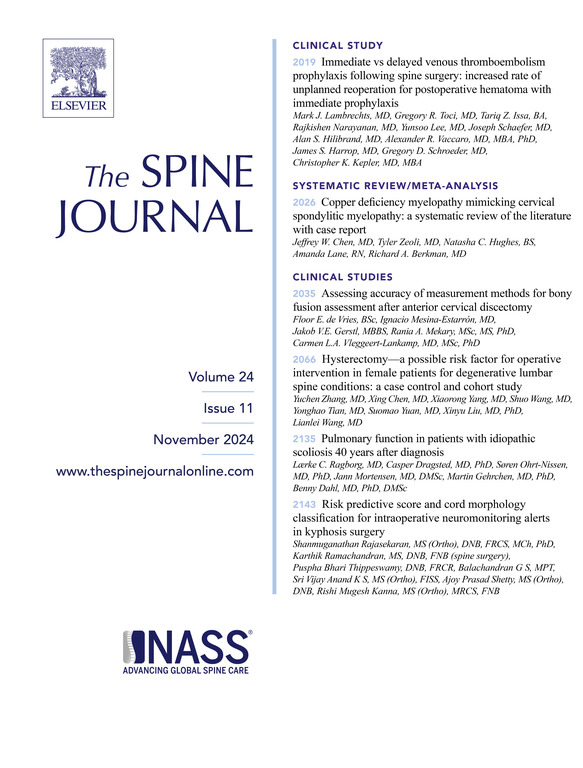Is osteoporosis an independent risk factor for sacral fracture after lumbosacral spinal fusion in adults? A retrospective cohort study
IF 4.7
1区 医学
Q1 CLINICAL NEUROLOGY
引用次数: 0
Abstract
BACKGROUND CONTEXT
Sacral fracture is a rare complication following lumbosacral fusion in adults linked to postsurgical biomechanical changes. There are mixed research results suggesting that osteoporosis may or may not be a contributing factor.
PURPOSE
To determine if osteoporosis is an independent risk factor for sacral fracture after lumbosacral fusion.
STUDY DESIGN
A propensity-matched retrospective cohort study that was preregistered on open science framework.
PATIENT SAMPLE
After matching, patients (n=14,302; 82% female) who underwent lumbosacral fusion had a mean age of 64 years and were divided into the osteoporosis cohort (n=7,151) or the no osteoporosis cohort (n=7,151).
OUTCOME MEASURES
The primary outcome measure was the risk ratio (RR) of sacral fracture through 2 years after lumbosacral fusion. We secondarily explored the RR for pelvic fixation with instrumentation. We assessed negative control outcomes such as further imaging and major trauma, targeting near-null point estimates.
METHODS
We included adults (≥18 years old) in the TriNetX database from 2005 to 2023 who underwent primary lumbosacral fusion, divided into two cohorts depending on the presence or absence of osteoporosis (ie, osteoporosis and no osteoporosis cohorts) and propensity matched via key risk factors.
RESULTS
There were 261 (1.8%) sacral fractures in the entire patient population (n=14,302). Comparing the osteoporosis cohort to no osteoporosis cohort, there was a statistically significant increase in risk of sacral fracture (RR: 1.75 [1.36, 2.24]; p<.001; 166 [2.3%] vs 95 [1.3%] cases), with a median time to event of 154 and 181 days in each cohort, respectively. There was also a statistically significant increase in risk of pelvic fixation with instrumentation (RR: 1.87 [1.25, 2.78]; p=.002). The likelihood of polytrauma (RR=0.98), subdural hemorrhage (RR=1.24), and diagnostic imaging (RR: 0.93) approximated the null between cohorts, suggesting findings would not be explained by differences in these variables.
CONCLUSION
Osteoporosis appears to be independently associated with a statistically and clinically significant risk of sacral fracture through 2 years after lumbosacral fusion. Further research may be warranted for corroboration.
骨质疏松是成人腰骶椎融合术后骶骨骨折的独立危险因素吗?回顾性队列研究。
背景:骶骨骨折是成人腰骶融合术后与术后生物力学变化相关的罕见并发症。有不同的研究结果表明,骨质疏松症可能是或可能不是一个促成因素。目的:确定骨质疏松是否是腰骶融合术后骶骨骨折的独立危险因素。研究设计:一项倾向匹配的回顾性队列研究,在开放科学框架上预先注册患者样本:匹配后,患者(n= 14302;接受腰骶融合术的患者(82%为女性)平均年龄为64岁,分为骨质疏松组(7151例)和非骨质疏松组(7151例)。观察指标:主要观察指标为腰骶融合术后2年内发生骶骨骨折的风险比(RR)。其次,我们探讨了内固定骨盆的RR。我们评估了阴性对照结果,如进一步影像学检查和重大创伤,以接近零点的估计为目标。方法:我们在TriNetX数据库中纳入了2005-2023年间接受原发性腰骶融合术的成年人(≥18岁),根据有无骨质疏松症(即骨质疏松症和无骨质疏松症队列)和通过关键危险因素匹配的倾向分为两组。结果:全部患者中有261例(1.8%)骶骨骨折(n= 14302)。骨质疏松组与无骨质疏松组比较,骶骨骨折风险增高有统计学意义(RR: 1.75 [1.36, 2.24];结论:在腰骶融合术后两年内,骨质疏松似乎与具有统计学意义和临床意义的骶骨骨折风险独立相关。可能需要进一步的研究来证实。
本文章由计算机程序翻译,如有差异,请以英文原文为准。
求助全文
约1分钟内获得全文
求助全文
来源期刊

Spine Journal
医学-临床神经学
CiteScore
8.20
自引率
6.70%
发文量
680
审稿时长
13.1 weeks
期刊介绍:
The Spine Journal, the official journal of the North American Spine Society, is an international and multidisciplinary journal that publishes original, peer-reviewed articles on research and treatment related to the spine and spine care, including basic science and clinical investigations. It is a condition of publication that manuscripts submitted to The Spine Journal have not been published, and will not be simultaneously submitted or published elsewhere. The Spine Journal also publishes major reviews of specific topics by acknowledged authorities, technical notes, teaching editorials, and other special features, Letters to the Editor-in-Chief are encouraged.
 求助内容:
求助内容: 应助结果提醒方式:
应助结果提醒方式:


